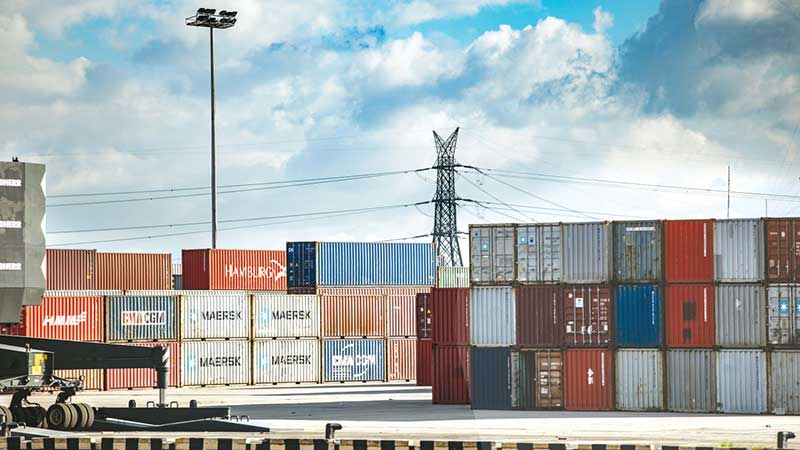Published in The Business Standard on Wednesday 8 January 2020
Export growth rate has become a contentious issue after Export Promotion Bureau of Bangladesh shown a 6 percent drop in the first six months of the current fiscal.

If we look into the export data of the first half of the 2019-20 fiscal year, we witness a drop in export rate on most of the products, including readymade garments. Some of the sector however had a positive growth rate as well. For example, in jute product export we have seen 22 percent growth rate. Also, small industries such as the pharmaceuticals, lightweight machineries have seen a growth during this time.
But, as we export very small amount of these products, it is not possible for these industries to contribute substantially in our economy.
Another positive aspect of the economy is that the export data shows a positive growth rate in December. We have gained 2.5 percent growth rate in the last month. But among such positive news, the decline we have seen in the export growth rate throughout the first six months of the current fiscal year is a matter of serious concern.
In comparison with the first six months of 2018-19 fiscal year, in the first half of 2019-20 fiscal our export dropped by $1 billion. By looking at the actual scenario one may conclude that we have not changed our business patterns and the demand has not grown as well. But this is not the only reason behind the drop in export growth rate.
The cycle of growth in the first six months of the current fiscal year, uncertainty in doing business, global issue of unemployment and the global unrest, including the US-China trade war and Brexit have played their role too.
Due to the unrest in global economy and unemployment, the consumer spending declined – people are not spending the way they used to. From the economic point of view, this is a normal tendency of the consumers and it happens every time there is an uncertainty in employment and an instability in global economy. For this reason our main export products such as the readymade garments is facing a negative impact in the global imports. But this is not happening exclusively to Bangladesh. Other countries are facing the same issue as well, though they might still have a positive export growth rate.
But I want to add a crucial information here regarding the export growth data. Usually journalists extract data from Export Promotion Bureau of Bangladesh (EPB) whenever they do a report. But we can also gather data from other sources. For example, Bangladesh Bank also publishes export data. If we look into the data provided by the two agencies till November 2019, we can see a big difference between the data of central bank and EPB and the difference stands at more than $2 billion.
When the EPB is showing a negative growth rate during these months, Bangladesh Bank on the other hand has shown a positive growth rate. I have also done an analysis till October and found that the growth rate was more than 4 percent, whereas EPB reported that the growth rate was minus 6.5 percent.
There might be many ways to explain this difference, but a clarification should come from their end to understand the actual scenario of export growth rate. One explanation would be that this difference arose probably because the EPB report is prepared based on the products that were exported and Bangladesh Bank report hinges on the tally of the exported products when they are received.
But then a question arises, as the central bank is showing lower income, does that mean that some exported products had not been received by buyers. Or, is it because of the payment that the exporters have been complaining about, the amount that they did not receive from the buyers, which has affected their tally?
Bangladesh is certainly falling behind. Vietnam, on the other hand, is doing well in the export sector. Vietnam’s rise in export is explained in terms of China’s “new normal policy” and also because of orders that got shifted from China to other countries – this is the result of the US-China trade war. But Bangladesh is not getting the orders that are being shifted to other countries. The reason behind this is that we do not have a wide range of diverse products.
We have to remember that in the current market we are not the only one who can produce RMG products. The market is really competitive and this is why diversity is necessary. Also, the rise of digital trade is a global phenomenon and online marketing has become an important issue.
We have many weaknesses when it comes to developing an infrastructure for the online market. This market requires the producers to accomplish everything in a timely manner, which includes receiving the orders and delivering the products. As we face delays in our ports and if we continue fail in bringing down our lead time, it will not be possible for us to build the required infrastructure.
To match the pace with which the rest of the world operate, we need to think innovatively and invest in the areas that will bring economic development in the future. We need to improve our infrastructural system of export processing and reform the current incentive structure. The money might be used in the same sector, but we need to know the specific tools required for market development. Only then will the government be able to assist these sectors in the light of the specific needs.
Dr Khondaker Golam Moazzem is an industrial economist by profession and research director of Centre for Policy Dialogue (CPD).



